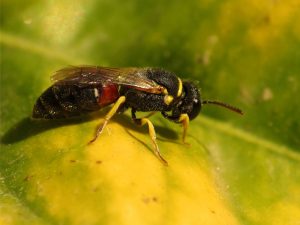07
Oct
Seven Bee Species Make Endangered Species List
(Beyond Pesticides, October 7, 2016) For the first time in U.S. history, the U.S. Fish and Wildlife Service (FWS) has added a group of bees to the list of Endangered Species. FWS published a final rule last Friday that declares seven species of yellow-faced bees (genus Hylaeus) that are native to Hawaii as endangered. This announcement immediately follows last week’s news that FWS has proposed listing the rusty patched bumble bee as an endangered species under the Endangered Species Act (ESA).
 While the decision is great news for these bees and the environmental groups who have fought to protect them, there is still much work that needs to be done, and FWS says that it needs additional time to identify specific areas to be designated as critical habitat for the endangered bees. Further, though FWS has identified many threats to bees, including habitat loss and degradation due to urbanization, and other human activities, the final rule does not specifically point to pesticides. However, there is an overwhelming amount of research demonstrating that neonicotinoid insecticides, working either individually or synergistically, play a critical role in the ongoing decline of bees and other pollinators.
While the decision is great news for these bees and the environmental groups who have fought to protect them, there is still much work that needs to be done, and FWS says that it needs additional time to identify specific areas to be designated as critical habitat for the endangered bees. Further, though FWS has identified many threats to bees, including habitat loss and degradation due to urbanization, and other human activities, the final rule does not specifically point to pesticides. However, there is an overwhelming amount of research demonstrating that neonicotinoid insecticides, working either individually or synergistically, play a critical role in the ongoing decline of bees and other pollinators.
Neonicotinoids have been linked to a range of both acute and chronic effects on pollinators. Studies have found the insecticides can adversely affect reproduction, impair pollination, and alter behavior. Once these chemicals are used in the environment, their persistence and long half-life means that they remain a problem for beekeepers well into the future.
This final rules comes one year to the day since the proposed rule was published, and following a multi-year effort by the Xerces Society, which submitted petitions to FWS in March 2009, to gain recognition and protection for these bees. According to Xerces, these bees are often found in small patches of habitat connected by agricultural land or developments. There is only one genus of bees that is native to the Hawaiian Islands, Hylaeus, commonly called yellow-faced bees because of colored markings on their faces.
These bees are often found in small patches of habitat hemmed in by agricultural land or developments. This is particularly troubling as Hawaii’s year-round growing conditions have made it a prime target for agrichemical companies to test new, experimental forms of genetically engineered (GE) crops, which brings with it increased pesticide use. Data released last year reveals that high levels of restricted use pesticides, in some cases almost double the pounds per acre average of other states, are being used in Kauai County. A May 2014 report found 25 herbicides, 11 insecticides and 6 fungicides in Hawaii’s waterways, underscoring concerns for ecological health. Further, a study published earlier this year found that even when attempting to protect pollinators by planting pollinator habitat and hedgerows around conventional farms, neonicotinoids used onsite can make their way into flowering crops in field margins, putting pollinators in danger.
For these reasons and many others, Beyond Pesticides works to promote the widespread transition of conventional farmland to organic production. With one in three bites of food reliant on pollination from bees, other insects, and birds, the decline in pollinators due to pesticides, and other human-made causes, demands immediate action. For help on how you can get involved to reverse pollinator declines, see Beyond Pesticides’ Bee Protective webpage. And for more information on why organic is the right path for the future of agriculture, see Beyond Pesticides Organic Agriculture program page.
All unattributed positions and opinions in this piece are those of Beyond Pesticides.










